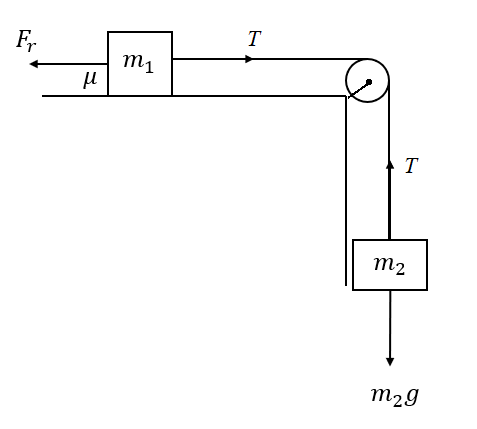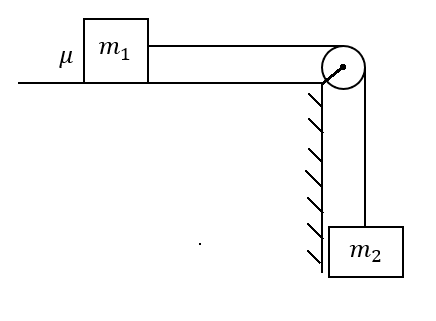Answer
414.9k+ views
Hint: Apply Newton’s second law of motion to both the masses and rearrange the equations you got to determine the effective acceleration of the system.
Complete step by step answer:
Draw a free body diagram to denote the forces acting on the above system as follows,

In the above free body diagram, \[{F_r}\] is the frictional force acting on the mass \[{m_1}\], T is the tension in the string, and \[{m_2}g\] is the weight of \[{m_2}\].
Apply Newton’s second law of motion on the mass \[{m_1}\] as follows,
\[{F_{net}} = {m_1}a\]
\[ \Rightarrow T - {F_r} = {m_1}a\] …… (1)
We know that the frictional force acting on the mass \[{m_1}\] is given by the equation,
\[{F_r} = \mu {m_1}g\]
Therefore, equation (1) becomes,
\[ \Rightarrow T - \mu {m_1}g = {m_1}a\] …… (2)
Apply Newton’s second law of motion on the mass \[{m_2}\] as follows,
\[T - {m_2}g = {m_2}\left( { - a} \right)\]
\[ \Rightarrow T - {m_2}g = - {m_2}a\] …… (3)
Here, the negative sign of the acceleration implies that the mass is accelerated in the downward direction.
Subtract equation (2) from equation (3).
\[T - {m_2}g - \left( {T - \mu {m_1}g} \right) = - {m_2}a - {m_1}a\]
\[ \Rightarrow {m_2}g - \mu {m_1}g = \left( {{m_1} + {m_2}} \right)a\]
\[\therefore a = \dfrac{{\left( {{m_2} - \mu {m_1}} \right)}}{{\left( {{m_1} + {m_2}} \right)}}g\]
So, the correct answer is “Option D”.
Note:
Always specify the direction of the forces and the direction of the acceleration of the body. In this problem, the direction of the mass \[{m_1}\] is towards right and hence taken positive while the direction of the acceleration of the mass \[{m_2}\] is downwards, hence taken as negative.
Complete step by step answer:
Draw a free body diagram to denote the forces acting on the above system as follows,

In the above free body diagram, \[{F_r}\] is the frictional force acting on the mass \[{m_1}\], T is the tension in the string, and \[{m_2}g\] is the weight of \[{m_2}\].
Apply Newton’s second law of motion on the mass \[{m_1}\] as follows,
\[{F_{net}} = {m_1}a\]
\[ \Rightarrow T - {F_r} = {m_1}a\] …… (1)
We know that the frictional force acting on the mass \[{m_1}\] is given by the equation,
\[{F_r} = \mu {m_1}g\]
Therefore, equation (1) becomes,
\[ \Rightarrow T - \mu {m_1}g = {m_1}a\] …… (2)
Apply Newton’s second law of motion on the mass \[{m_2}\] as follows,
\[T - {m_2}g = {m_2}\left( { - a} \right)\]
\[ \Rightarrow T - {m_2}g = - {m_2}a\] …… (3)
Here, the negative sign of the acceleration implies that the mass is accelerated in the downward direction.
Subtract equation (2) from equation (3).
\[T - {m_2}g - \left( {T - \mu {m_1}g} \right) = - {m_2}a - {m_1}a\]
\[ \Rightarrow {m_2}g - \mu {m_1}g = \left( {{m_1} + {m_2}} \right)a\]
\[\therefore a = \dfrac{{\left( {{m_2} - \mu {m_1}} \right)}}{{\left( {{m_1} + {m_2}} \right)}}g\]
So, the correct answer is “Option D”.
Note:
Always specify the direction of the forces and the direction of the acceleration of the body. In this problem, the direction of the mass \[{m_1}\] is towards right and hence taken positive while the direction of the acceleration of the mass \[{m_2}\] is downwards, hence taken as negative.
Recently Updated Pages
How many sigma and pi bonds are present in HCequiv class 11 chemistry CBSE

Why Are Noble Gases NonReactive class 11 chemistry CBSE

Let X and Y be the sets of all positive divisors of class 11 maths CBSE

Let x and y be 2 real numbers which satisfy the equations class 11 maths CBSE

Let x 4log 2sqrt 9k 1 + 7 and y dfrac132log 2sqrt5 class 11 maths CBSE

Let x22ax+b20 and x22bx+a20 be two equations Then the class 11 maths CBSE

Trending doubts
Fill the blanks with the suitable prepositions 1 The class 9 english CBSE

At which age domestication of animals started A Neolithic class 11 social science CBSE

Which are the Top 10 Largest Countries of the World?

Give 10 examples for herbs , shrubs , climbers , creepers

Difference between Prokaryotic cell and Eukaryotic class 11 biology CBSE

Difference Between Plant Cell and Animal Cell

Write a letter to the principal requesting him to grant class 10 english CBSE

Change the following sentences into negative and interrogative class 10 english CBSE

Fill in the blanks A 1 lakh ten thousand B 1 million class 9 maths CBSE




